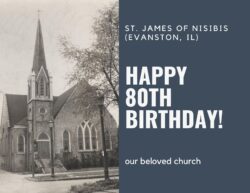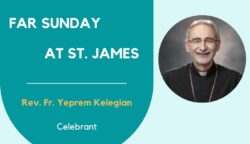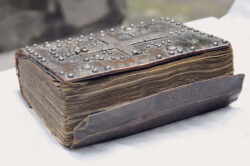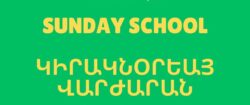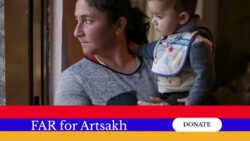A Family Guide for Meaningful Participation
Imagine inviting people you love to your home for dinner and when you invite them to the table, your loved ones decline! It’s the same thing in Badarak: our Lord has invited us to His table, to share in His very essence – His Body and Blood as embodied in the bread and the wine. Only in this way do we become the Church: as we gather in His name and remember Him as He commanded His disciples to do more than two thousand years ago. Holy Communion is the most intimate encounter we can have with God in this life.
Here are some important things to know historically, theologically, and practically.
A historical overview
- At what is now known as The Last Supper, Jesus and his disciples were gathered for the Passover meal in the upper room of an inn. It is here, during this traditional meal, that Jesus did something completely different. “While they were eating, Jesus took bread, gave thanks and broke it, and gave it to his disciples, saying, ‘Take and eat; this is my body. Do this in remembrance of me.’ Then he took the cup, gave thanks and offered it to them, saying, ‘Drink from it, all of you. This is my blood of the covenant, which is poured out for many for the forgiveness of sins.'” (Matthew 26:28-28; Luke 22:19)
- Based on Jesus’ exhortation to share new life in Him by gathering to break bread and share a common cup, early Christian worship centered on a communal meal. Although ideas varied as to what was shared – bread, wine, water, cheese, fish, fruit, etc. – Christian documents from that time confirm that it was a literal meal, most likely in the evening, in someone’s home with the food provided by those who gathered.
- Eventually, the meal became part of a ritual meal (depicted in Roman catacomb paintings as early as the second century) during which bread and wine were blessed and shared. These meals also featured Scripture reading, psalm singing, preaching, and a shared meal. While the fellowship meals continued, the ritual of bread and wine moved to a central place in Sunday worship. Believers understood that in receiving this bread and wine, they were sharing in the very body and blood – that is, the very essence – of their Lord. “He who eats my flesh and drinks my blood abides in me and I in him.” (John 6: 56)
- Over the centuries, the form of this liturgy developed into a basic format with its local variations and influences. Because there was so much improvisation of prayers, etc, efforts to permanently “fix” the text began as early as the 4th century.
- Since 1177, when Nerses of Lampron wrote his commentary on the Badarak, the liturgy has remained unchanged with some minor exceptions, for example, modifications made as a result of contact with Roman Catholic Crusaders (the use of the bishop’s miter and the final blessing), as well as the insertion of the popular “Der Voghormya” hymn in the 18th century.
A theological overview
- In the first part of the Divine Liturgy, Jesus comes to us through His Word, the Gospel reading. In the second, through His Body and Blood, or Holy Communion. In a very fundamental way, each of these is an “incarnation.”
- When we fall short of the high calling of Christianity as we are bound to do, the sacrament of Holy Communion provides a way to express our remorse and our desire to return to the path that leads to God.
- It is an ancient tradition of the Church that even before receiving Holy Communion, the faithful have opportunities to examine their lives and confess individually to a priest. In America it has become the custom to offer a general confession and absolution immediately before Holy Communion is distributed. The people read a prepared examination of conscience and then the priest, not by his own authority, but by the very word of Jesus Christ, absolves the sins of all who have made confession.
Participating Meaningfully in Holy Communion
- Prepare: Fast the morning of receiving communion and do your best to get ready and leave for church graciously and unhurriedly, with a minimum of family chaos. Make time to read the day’s Scripture readings (available at www.armenianchurch.net) and discuss on the way to church.
- Participate: Sing all the hymns, respond to the priest’s blessings and the deacon’s petitions, bow, cross yourself, kneel. The word Liturgy itself means “work of the people.” We are called to actively participate in all aspects of the Badarak.
- Follow the service by using the liturgy book: As time goes by you will become increasingly familiar with the words and their meanings.
- Be thoughtful during confession: Spend time before church and during the confession recitation to prayerfully reflect on how you have fallen short in the ways enumerated. Commit yourself to working actively to “sin no more.”
- Be a conscientious Bible student: Read Scripture daily and join your parish Bible study. Follow the church calendar to read Scripture at family meals. Since the Bible is the foundation of our liturgy, look up all the Scripture references you find in the liturgy book.
- Take home mas: Share the blessed bread of the liturgy with people who were not able to come.
Back in the 10th century, the great Armenian theologian Khosrov Antsevatsi eloquently described the importance of the Divine Liturgy when he wrote: “Since those who confess and show repentance receive atonement by means of the Holy Mystery [the badarak], and are reunited to Christ in order to become for Him body and members, we should be eager for the great medicine.”
The Divine Liturgy is the great medicine that provides true meaning and direction for our lives. It offers the peace and solace that only God can give – a free gift no less – in an age when so many people are searching, and spending millions of dollars in vain to find personal stability and security. (Excerpt by Fr. Daniel Findikyan)
Click here to watch video about communion (in Armenian).



